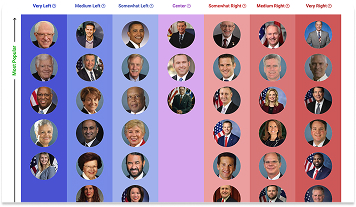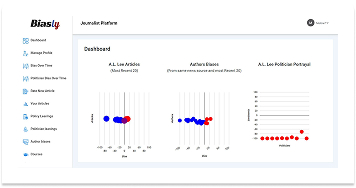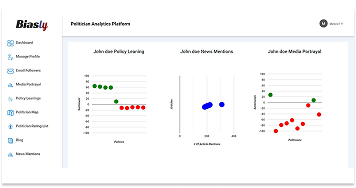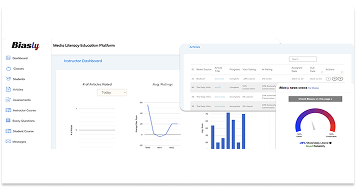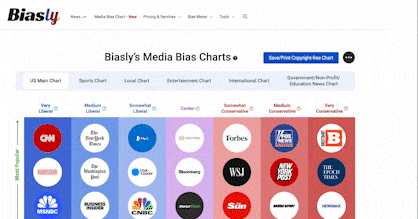Bias Meter
Extremely
Liberal
Very
Liberal
Somewhat Liberal
Center
Somewhat Conservative
Very
Conservative
Extremely
Conservative
-100%
Liberal
100%
Conservative
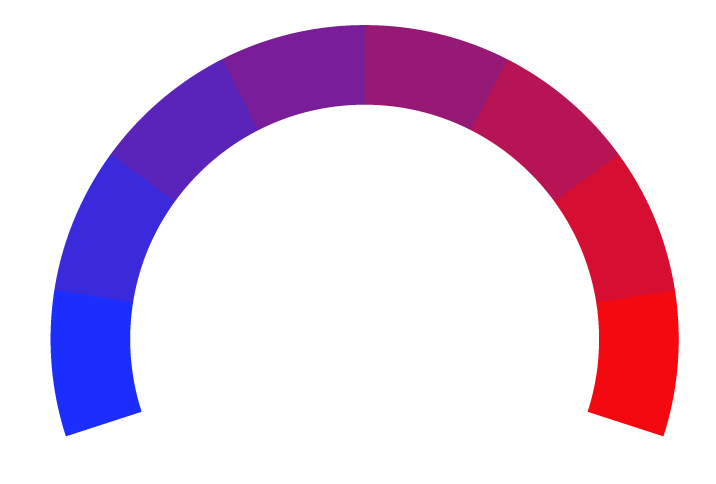
Biasly determines media bias ratings through a dual-layered approach combining artificial intelligence and analyst review. The platform’s proprietary bias detection engine, Bias Meter, evaluates sentiment, policy position alignment, and language framing across thousands of data points in news articles. Analysts then verify and interpret the AI’s findings, providing additional context where needed. Learn more
- Profile
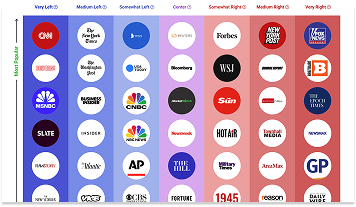
Deseret News on the media bias chart
Deseret News has a Bias Score of 6% Center which is based on a variety of factors including its policy and politician leanings, article ratings, and the use of biased language. Its Reliability is rated as Good, and additional analytical insights are available in the other tabs.
- Bias Rating
6% Center
- ReliabilityPolicy Leanings
0% Center
Extremely
LiberalVery
LiberalModerately
LiberalSomewhat Liberal
Center
Somewhat Conservative
Moderately
ConservativeVery
ConservativeExtremely
Conservative-100%
Liberal100%
Conservative
Good Reliability
*Our bias meter rating uses data science including sentiment analysis, machine learning and our proprietary algorithm for determining biases in news articles. Bias scores are on a scale of -100% to 100% with higher negative scores being more liberal and higher positive scores being more conservative and 0% being neutral. The rating is an independent analysis and is not affiliated nor sponsored by the news source or any other organization.
Politician Portrayal23% negative
Continue For Free
Create your free account to see the in-depth bias analytics and more.
By creating an account, you agree to our Terms and Privacy Policy, and subscribe to email updates.
Policy Leanings Analysis
Policy | Bias score |
|---|
Deseret News Editorial Patterns
Deseret News’s coverage of political topics reflect Center Bias. The newspaper’s consistent pattern of pulling direct quotes and refraining from overt commentary means its editorial slant, if existing, depends on its source selection. While the publication demonstrates journalistic standards in many of its reports, the choice of issues, framing, and word usage can indicate a political slant as well, although less often. This content analysis examines how Deseret News handles both liberal and conservative issues and evaluates its language choices and editorial tendencies.
Coverage of Liberal vs. Conservative Topics
Deseret News covers a range of issues across the political spectrum, often presenting multiple viewpoints within a single article. Media bias charts often make specific note of this practice when making evaluations. Recent reporting on immigration policy, for example, has included both border enforcement measures and humanitarian concerns related to asylum seekers. This highlights the differing priorities of the two major political parties.
On state-level issues like abortion, the newspaper tends to adopt a slightly more conservative tone. This aligns with Utah’s predominantly Republican political landscape, where local policymakers often drive the legislative agenda. Still, the newspaper generally leans on direct quotations and avoids overt editorializing. This restrained and fact-focused reporting style appeals to readers seeking unbiased news sources or looking to understand bias in media.
In national coverage, such as reporting on the president or federal policies, Deseret News conveys information objectively and accurately. However, controversy is occasionally downplayed or framed in less confrontational terms. This does not accurately reflect every issue relating to Donald Trump. Analyses of recent articles indicate that conservative arguments are more likely to be sourced from official or institutional voices. Conversely, liberal perspectives may be supported by less formal or more generalized commentary. Subtle imbalances in sourcing, such as this, contribute to a perceived tilt, even if the tone remains civil and measured. Similar findings can be found with news bias analytics software, like that used by Biasly.
Analyses of recent articles indicate subtle sourcing imbalances, such as:
- Conservative viewpoints cited through official or institutional sources
- Liberal perspectives are more often represented through general commentary
- Occasional softening of language around conservative-led controversies
Policy and Issue Framing
Deseret News often approaches policy topics through a lens shaped by traditional values, with particular emphasis on faith, family, and community. Utah has a dominant political and cultural climate in which conservative values thrive. The newspaper’s framing tends to align with the culture when it comes to issues like abortion and religious liberty. This trend also appears in media bias ratings and news bias chart assessments, as it is a heated political issue. The language used in Deseret’s online articles can especially reinforce moral or ethical considerations. Highlighting voices from church leaders, conservative policymakers, and family-centered advocacy groups are a few of the ways this is done.
In contrast, the coverage is typically more reserved when addressing topics associated with progressive agendas, such as climate change, immigration, or LGBTQ+ rights. These articles tend to include opposing viewpoints, but often emphasize moderation or express caution. For example, environmental concerns may be addressed through the lens of stewardship or community responsibility rather than urgent activism. Similarly, reporting on immigration may balance humanitarian concerns with law enforcement perspectives, subtly reinforcing a preference for orderly processes.
Even when striving for neutrality, Deseret News demonstrates framing patterns through word choice and sourcing. Policies backed by conservative figures are often described as promoting “freedom,” “protection,” or “preservation.” Liberal policies may be portrayed as “challenging tradition” or “prompting debate.” This reflects patterns observed across the media bias chart and in tools used by media literacy organizations and bias meter platforms. These subtle linguistic choices contribute to a tone that reveals a composed right-of-center bias, even in coverage of contentious social issues.
Coverage and Relevance
The Deseret News frequently reports on topics central to the broader conversation about media bias and political tone in journalism. As a prominent Utah-based outlet, it offers a compelling case study for examining how regional values influence editorial direction. Its approach to contentious issues through careful sourcing and a moderate voice also highlights the importance of rhetoric. Emphasis on certain viewpoints can reflect a mild conservative bias, but the credibility and relevance in state-focused reporting remain intact.
Deseret News Bias Analysis
Is Deseret News Biased?
Based on Biasly’s evaluations, Deseret News is rated as Center.
Deseret News is the longest-running news organization in Utah and the state’s oldest continuously operating business since it was founded in 1950. Today, Deseret News has an average of 118,246 monthly visits according to SimilarWeb. The outlet has embraced the expansion of digital news, gaining recognition in 2012 as the second-fastest-growing newspaper in the U.S. As it shifted its focus towards digital platforms along with broader industry trends, the newspaper also emphasized values-based journalism. As a local news outlet, Deseret News is able to cover a wide range of topics, while also getting into the specifics of what is happening in the Salt Lake City community. Its coverage also features national news and includes topics ranging from politics to religion.
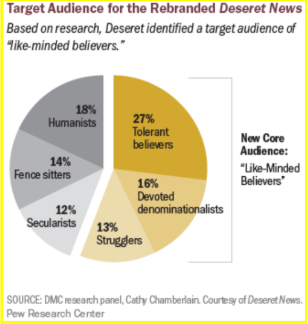
Source: Pew Research
The news outlet is a subsidiary of the Deseret Management Corporation, which is owned by The Church of Jesus Christ of Latter-day Saints, or LDS. It is thus inferred that there is a system of commonly held beliefs among managers of Deseret News. The paper’s journalistic integrity does not appear to be compromised on such grounds; however, it is a significant connecting point between the business and its audience to consider. Members of the LDS represent 61.46% of Utah’s population as of 2025, meaning Deseret News targets a majority of the population in the state of Utah.
How Does Biasly Rate News Sources?
Biasly uses proprietary algorithms and a team of analysts to provide comprehensive bias evaluations across thousands of news outlets. Over 200,000 articles from more than 3,200 sources have been analyzed to identify the most accurate and unbiased stories.
Biasly assigns each outlet three key scores:
- Reliability Score – Reflects factual accuracy
- AI Bias Score – Generated via natural language processing
- Analyst Bias Score – Assessed by human political analysts
These scores are based on seven core metrics: Tone, Tendency, Diction, Author Check, Selection/Omission, Expediency Bias, and Accuracy. These elements help analysts and algorithms evaluate the political attitude conveyed by each article.
Biasly’s Bias Meter ranges from -100% (most left) to +100% (most right), with 0% indicating neutrality. The system evaluates individual articles based on political terms, policies, figures, and sentiment to calculate precise bias ratings.
Is Deseret News Politically Biased?
Deseret News earns a Center rating for its AI Bias Score and Center rating for its Analyst Bias Score. The Analyst Bias Score is generated by reviewers from liberal, moderate, and conservative backgrounds.
Deseret News has confidently addressed its position on bias and fake news as concerns rise, even encouraging media literacy for readers. The staff agreed in a joint article,
“What’s clear is that Americans need to boost their media literacy to navigate an increasingly complex landscape, perhaps by starting with a walk on the other side.”
The article identified the main source of division and addiction in readers as being a media profit model. The idea is that reporters are often biased because they are working for a business, which, like any other, must generate money in the most efficient manner.
“To make the addiction model profitable, media companies need consumers to have strong feelings.” Pew Research offers insight into the design of Deseret News as a business, addressing concerns that a new organization owned by a religious organization has an underlying agenda. In light of this, media literacy courses educate readers on how to navigate agendas by understanding media ownership and bias.
Analysis of Bias in Deseret News Online Articles
When Deseret News made adjustments to its business plan, it decided to use growing digital media platforms as a resource. Gilbert Clark, the past CEO of the Deseret, told Pew Research, “The mission is to produce quality enterprise journalism on a range of topics that he believes much of the media does not understand.” Clark had high expectations for the journalistic integrity of his corporation. He also expressed the importance of bringing attention to questions audience members might already be asking.
Is this approach to journalism simply highlighting what is most relevant, or is it more easily prone to selection bias? Let’s look at some of their articles in more detail below to identify the signs.
When determining bias, some of the most common metrics used include Tone, Tendency, Author, Diction, and Expediency Bias, which are the primary metrics we’ll focus on below.
- Tone: This represents the attitude of the writing, formed distinctively but related to the author’s word choices or diction.
- Diction: The specific words chosen by the writer.
- Author: A metric related to the article’s author, taking into account their history of stance on issues based on past articles and social media posts.
- Tendency measures how consistently an author shows bias in their work, including factors like their tone and perspective.
- Expediency Bias relates to the immediate impression created by elements like the article’s headline, images, or summary, indicating if they favor a particular viewpoint.

Source: Deseret News
This article provides an excellent example of a neutral first impression. While Deseret does not downplay the significance of Israel’s proposal, its headline is void of emotional language. The reporter dissuades the audience from crediting the publication for finding the knowledge through her passive use of ‘said.’ Furthermore, the image does not show parties responsible for the decision of a ceasefire, but rather a group that will be affected by it.
The image evokes sympathy as it depicts people in need, but it does not make statements in and of itself. When images are often used to flatter or antagonize political actors, highlighting a third party can be the safest route.
A more prominent example of Deseret News’s variation in viewpoints is found in the article titled “A few big surprises: What you didn’t notice in Trump’s big tax bill.” The author uses unsettling language in her title to spark curiosity and concern in potential readers. It implies a lack of specific necessary information. The subtitle only vaguely unpacks the reporter’s statement,
“Republicans included a number of unexpected items in the package that was finished just hours before it was passed.”
This causes readers to wonder early on if they are responsible for the lack of information or the politicians mentioned. Mondeaux, the author, appears to believe the latter, as we pick up hints of negative sentiment towards Republican President Trump in her rhetoric.
“But surprise: The 1,038-page document that was finalized overnight and voted on just hours later has a number of provisions that weren’t widely known until after it was passed.”
Mondeaux’s sarcasm insinuates that the Republican Party has a history of using questionable or dishonest strategies for achieving its goals. Her skepticism is further solidified when she references another of her articles titled “House passes Trump’s ‘big, beautiful bill,’ in massive win for GOP agenda.”
Mondeaux uses the term ‘agenda’ for Republican plans, carrying negative connotations that further reflect her opposition to secrecy. She also says that the passing of the bill was ‘managed.’ Mondeaux is more assertive when sharing that only the policymakers could celebrate the bill’s passing as a win.
Despite the transparency in the author’s beliefs towards policy development, the content of the article is founded on reliable information. The use of commonly shared knowledge makes it more accessible to readers. Overall, it accurately outlines the bill and even attaches a link for readers to cross-examine themselves.
Concerning external opinion, Monteaux only included those directly involved with the event, such as Rep. Mike Flood.
“I am not going to hide the truth. This provision was unknown to me when I voted for that bill,” Rep. Mike Flood, R-Neb., told voters in his district this week. “And when I found out that provision was in the bill, I immediately reached out to my Senate counterparts and told them of my concern.”
This offers a well-founded basis for the claims that Monteaux opens with. The reporter projects personal views toward the policy through rhetoric. However, she provides sufficient evidence; namely, first-hand sources such as official documents.
It can be noted that Mondeaux followed the story on Twitter. She displays a similar pattern of quoting lawmakers and other politicians in an accurate and concise manner. When she hinted at her interpretation, it was likewise through retweets or her own brief wording.
After GOP leaders spent all afternoon yesterday and this morning convincing Republicans the bill is good, Musk is out with new tirade against BBB
Johnson responds saying there isn’t time for a “new bill” pic.twitter.com/sx2SANZeai
— Cami Mondeaux (@cami_mondeaux) June 4, 2025
Another reporter for Deseret takes a less biased, although more optimistic approach in Caitlin Keith’s article, “Rep. Casey Snider to serve as new Utah House majority leader.” This article maintains a formal tone and emphasizes the significance of a change in leadership over the leadership itself.
“I am honored to take on this role and grateful for the opportunity to serve,” Snider said, according to a release from the caucus.”
Keith tugged on the excitement of the shift and quoted the positive language used in the caucus to lift the reader’s spirits.
The reporter also refrains from including any irrelevant information about the new members. She made short, simple statements about the logistical changes in the Utah House Majority Caucus. This article is a more accurate embodiment of the Desert News’ Center, or neutral bias.
One complaint readers could have about neutral reporting is its occasional hesitance to address controversy altogether. Remaining impartial is important, but it is vital to address differences that demand immediate attention when providing accurate coverage.
Keith’s optimistic perspective on local politics might trace back to her Utah residency. Her profile with Deseret News briefly mentions her background in the state, as well as pointing to other articles of similar coherence. Articles like Keith’s, which are neutral to the point of lacking controversy, are excellent opportunities for readers to cross-examine sources and conduct further research.
Analysis of Deseret News Opinion Articles
Opinion columns are an excellent place to look for underlying bias in news outlets. They give reporters more freedom to frame current events in favor of personal views. It is the publication’s responsibility to offer a balanced selection of these to avoid selection bias.
Consider this opinion article, “ The world can never afford to forget D-Day.” The title appeals to citizens of any part affiliation, and more broadly, ‘the world.’ The editorial board refers to a historical event that shaped the politics of the U.S., and consequently, foreign affairs.
“Today, the free world faces new threats from nations that seem to be consolidating power. A war is underway once more in Europe. The NATO alliance is facing pressure and threats. Unity is more important than it has been at any time since 1945.”
It is important to note that only constructive ideas elicit a sense of responsibility. Negative motivations are discouraged, such as the ‘consolidation of power.’ Nations were not specifically named, which further preserved the universality of the message. The call to unity and freedom remained inclusive and compelling to all readers.
The board also quotes Winston Churchill to show that the values upheld by Americans extend beyond the nation’s borders. Recognizing the collective contributions of many helps to affirm a shared potential to continue pursuing a common good. This establishes credibility through commonly respected and varied sources, much like factual reporting.
This article stands out as a strong example of fair and principled opinion writing due to its recognition of sensitive issues in both domestic and international politics, and a focus that transcends partisan blame.
Navigating news media bias in opinion can be more challenging, however, as political discussions become more specific. In his article “Medicaid cuts will harm children and education in Utah”, Kevin Korous opens with a personal anecdote. Media literacy touches on anecdotes among other types of bias, as it is often rooted in personal issues. Korous describes his mother’s experience with Medicaid as she cared for her sick child. Statements like “No school resource, excellent teacher, textbook, or private school voucher could have overcome these health-related speed bumps” as used. These suggest a subjective conclusion rooted in lived experience, which, while powerful, does not substitute for large-scale, controlled evidence.
Korous incorporates statistics about absenteeism and district-level Medicaid enrollment, but this information is presented as advocacy for a specific policy outcome. Therefore, objectives such as protecting or expanding Medicaid eligibility are typically aligned with Democratic Party platforms.
The call to “not underestimate the benefits of our social programs” and the critique of “budgetary justification” imply a counter-position to conservative fiscal policy. Journalist bias analytics tools take note of similar phrasing, as it makes a significant impact on the story’s slant. The article could be read as a subtle rebuttal to Republican-led efforts to cut Medicaid. Nonetheless, the writer uses neutral terms as he advances a policy preference that mirrors the partisan divide within Utah.
Who Owns Deseret News?
Deseret News is a subsidiary of the Deseret Management Corporation, a global operating company affiliated with the LDS Church. The church’s values of dignity, respect, and integrity are reflected in the corporation’s mission. It shares its desire to be a “trusted source of light and knowledge influencing hundreds of millions of people worldwide.” Today, Jeff Simpson serves as the president and chief executive officer of Deseret Management Corporation. Simpson has a diverse media background from his experience with Walt Disney, as well as BYU broadcasting and the Desert Book Company. His investment in community organizations and volunteer work is reflective of his ties with the church. The LDS Church is known in Salt Lake City for its collaborative efforts and media publications, like Deseret News.

Source: Deseret Management Corporation
Company leadership is delegated to various employees, and Burke Olsen is tasked with the management of Deseret News. Olsen served in other positions with Deseret News before becoming publisher. His experience with Pew Research Center, among other organizations, has contributed to the reputation of Deseret News in recent years.
How to Evaluate Bias
Although Biasly rates Deseret News as Center, it’s important to remember that bias can vary from article to article. This underscores the importance of examining each article individually. So, let’s learn how to evaluate media bias.
Recognizing media bias requires awareness and critical thinking. Often, readers trust news sources that affirm their existing beliefs—a psychological tendency known as confirmation bias. This makes it harder to identify slanted narratives or one-sided reporting.
To combat this, it’s essential to challenge your assumptions by consulting multiple viewpoints and verifying news through third-party analysis. Tools like Biasly’s media bias ratings allow readers to compare the same news story across the political spectrum.
Ultimately, bias isn’t always a matter of what is said—it’s also about what is left out, how topics are framed, and which stories are chosen for coverage. Learning to recognize these patterns can help readers make more informed decisions and develop greater media literacy.
To start comparing news outlets and gain a better understanding of bias, sign up for Biasly’s Media Bias & News Analytics Platform to see how stories vary between sources.
Deseret News Reliability Analysis
Is Deseret News Reliable?
From 2016 to 2024, Statista found that trust in local news sources like Deseret News remained higher than in national outlets. 71% of adults say that they trust local news compared to only 53% for national news. A Pew Research study has also highlighted Deseret News’ strong connections to a religious institution as a for-profit organization. According to Biasly, Deseret News leans moderately conservative in both its reporting and editorial tone, but maintains a Good reliability rating.
Despite allegations of bias for its ownership, Deseret News has engaged with broader media criticism and the evolving journalism landscape. In a 2023 op-ed, the outlet discusses public skepticism about journalism and calls for both introspection and accountability in modern reporting.
Given its complex background and evolving role in U.S. media, is Deseret News truly a reliable and unbiased source of information? At Biasly, we endeavor to evaluate the accuracy and dependability of all media outlets. Let us investigate the reliability and accuracy of Deseret News.
How to Evaluate Reliability?
Reliability refers to how trustworthy or accurate a news source is. If we can’t trust what we read, then continuing to consume content from that outlet serves little purpose. So how do we evaluate a news outlet’s reliability?
There are several potential measures of reliability to look out for when trying to determine whether a media source is reliable or not. Red flags for an unreliable article can include the presence of wild, unsubstantiated claims, facts dependent on other unreliable sources, heavy use of opinionated language, and more. In contrast, hallmarks of a reliable source include:
- Absence of subjective language
- Citing credible sources (e.g., .gov, .edu, academic references)
- Verifiable facts and statistics from multiple outlets
- Use of primary sources, like interviews or transcripts
- Consistency with coverage across other platforms
Biasly’s reliability scores incorporate these elements in evaluating media outlets.
So How Does Deseret News Fare in Its Reliability?
The political reliability index developed by Biasly assesses both accuracy and trustworthiness. Deseret News currently holds a Good Reliability Score, which is calculated as a weighted average of:
- Fact Analysis Score – Evaluates the accuracy of claims, facts, and evidence.
- Source Analysis Score – Assesses the number, diversity, and credibility of sources and quotes used.
Deseret News’s Source Analysis Score is rated Good at 83%. This suggests consistent trustworthiness in its sourcing practices. The score is AI-generated and considers quote length, frequency, diversity, and quality.
The Fact Analysis Score is similarly Good, at a __%. This score further determines how well Deseret News supports its claims, addresses selection and omission bias, and presents verifiable evidence. Until this is available, readers are encouraged to perform their own evaluations using Biasly’s media bias tools.
While Deseret News is known for factual reporting, occasional lapses can affect its reliability rating. Some examples of this are unbalanced support for varied viewpoints or incomplete data. Authors can also affect the bias presented in articles, as previously examined in Deseret’s articles. These nuances all emphasize the importance of analyzing individual articles.
Deseret News’s Accuracy and Reliability
According to Biasly’s analysis, Deseret News maintains Good Reliability Score, but individual articles may vary significantly. Let’s dive into the details.
Political orientation is known to significantly impact the bias and credibility of news organizations. Deseret News is one of many outlets that occasionally favors conservative viewpoints in its editorial content. Though faint, there is an ideological leaning to navigate in their articles. Using data and analysis will help us evaluate how well Deseret News supports its assertions with evidence and see whether its content is shaped by bias. Specifically, we will look at selection and omission bias to better understand the accuracy of its reporting.
Two common types of bias that affect factuality include:
- Selection Bias – Highlighting or omitting stories to fit a particular narrative.
- Omission Bias – Leaving out differing perspectives or relevant details to skew perception.
Biasly’s accuracy ratings use a scale from 1% (least accurate) to 100% (most accurate). Factors include the presence of supporting evidence, internal and external reliable sources, and balanced viewpoints.
Though Deseret News often meets high standards, certain articles may reflect stronger bias, particularly through omission or selective emphasis. This could be due in part to the publication’s mission-driven framework. The most extreme variations in dependability are caused by bias, notably omission and selection bias. As we analyze the integrity of Deseret News’ reporting, we will look closely at how these factors affect the objectivity and credibility of its journalism.
Consider TribLive, which also has a “Center” Bias and an “Average” analyst reliability rating according to Biasly. TribLive has one article, “Prosecutors charge Rep. Mclver with pushing, grabbing agents while trying to stop mayor’s arrest.” Biasly classifies this as somewhat right. Meanwhile, another article from the same source, “Judge in Johnstown becomes first in U.S. to uphold use of Alien Enemies Act to deport Venezuelans,” is somewhat left. It is the negative portrayal of politicians in both articles that contributes most heavily to their biases.
Deseret News likewise prompts a higher political portrayal score than overall bias while maintaining accuracy in its articles. Let’s take a look at “Why the Episcopal Church is ending its decades-long refugee ministry.” Influential actors are portrayed in a negative light, although through dependable sources.
Multiple perspectives, such as statements from Episcopal Church leaders and references to government policy changes, limit selection and omission bias. The article quotes Bishop Michael Curry and others involved in the refugee ministry, reinforcing a balanced perspective recognized in news bias ratings. It also includes a historical background to assist readers. The reporter uses data to support the claim that shifting federal policies under the Trump administration led to the church’s decision. One quote reads,
‘“It is just not sustainable anymore,” said Bishop Curry, noting how federal cuts have ‘undermined’ the infrastructure of church-based refugee resettlement.”
Unfortunately, readers gain limited insight into the rationale behind the federal changes. The article could be strengthened by including responses from a government representative or others involved in immigration policy from the opposing viewpoint.
However, it maintains a mostly factual and neutral tone overall, and its use of quotes and evidence sufficiently supports its content. A piece like this is considered reliable, even when its framing reflects a slightly conservative perspective. We will explore more Deseret News articles below to evaluate patterns of selection bias, omission bias, and factual reporting.
Analysis of Reliability in Deseret News’ Online News Articles
Deseret News’s online political reporting often displays a straightforward and objective tone. Its regular news coverage avoids overt ideological framing, despite being owned by a religious media company. The LDS Church has a reputation for its strong Conservative beliefs, according to religious landscape studies.
As we have mentioned, identifying an outlet’s religious affiliations as well as political leanings is important. However, assessing the credibility of information becomes increasingly crucial when these lines blur. The article “The BYU grad at the heart of Trump’s trade war”, for instance, draws attention to a figure with a similar background to readers of Deseret News.
The piece provides background on Greer’s education at Brigham Young University–an LDS-affiliated institution. It also focuses on his role at the conference, where he outlined trade negotiations. Although Bringham Tomco reports in a fairly neutral manner, Greer’s ties to the Trump administration and BYU speak for themselves.
This article is an example of reliable reporting. Slight political leanings are transparent but have low impact on the accuracy of the material. Broader ownership and business modeling do influence some of Deseret’s coverage selection, but not in every article.
This article still raises questions about the balance between delivering accurate news and appealing to a predominantly conservative audience. It underscores the ongoing challenge in digital journalism to maintain credibility while engaging diverse reader bases with differing political views. Typical online news articles are devoid of opinions and leanings from the author. Nonetheless, selection bias may occasionally single out stories in which to convey special interests.
Quality of Sources and Facts Used
Unlike many media outlets that heavily favor one ideological side, Deseret News has a Good reliability score in news bias ratings. Making a clear effort to present voices from different angles makes a big difference. In the article, “Utah relationship with Ute Indian Tribe shows a different approach Trump-New York mascot debate”, the writer used a relatively diverse set of sources. The article focused on the controversy surrounding Native American mascot bans in New York schools. The author highlights the Trump administration’s involvement in defending Massapequa High School’s “Chiefs” mascot.
The main identifiable sources are as follows:
- Donald Trump – Republican president
- Linda McMahon – Trump’s Education Secretary
- New York education officials – enforcing the mascot ban
- Federal judge ruling against Massapequa
- NAGA (Native American Guardians Association) – a Native-led pro-mascot group
- Historians and critics of Native mascots
- Tribal spokespersons opposing mascots (brief mention)
- Civil rights policy analysts
- Local school district officials
Many pro-mascot voices in the article were clearly named, such as Trump, his Education Secretary, and specific school leaders. Critics of the mascot, however, were sometimes paraphrased or attributed more generally, such as “tribal representatives argue.” This subtle imbalance in citation style doesn’t discredit the piece, but it is a framing choice worth noting.
That said, the article makes a commendable effort to include a variety of perspectives. It mentions Native voices on both sides of the issue, statements from New York state officials, and federal commentary. Especially when compared to more openly partisan outlets, this piece shows restraint in tone and balance in coverage.
Among Native groups, state officials, and civil rights activists, the federal administration’s viewpoint takes up the most space. Readers just might have benefited from more statistical or factual context for more balanced coverage. Studies on the psychological effects of Native mascots or polling data about tribal support and opposition are helpful supplemental research.
The main focus of the article was the political battle, and particularly Trump’s intervention. This appropriately aligns with the piece’s placement under political coverage. It is also worth recognizing, however, that for many Native communities, cultural representation is inherently political; a nuance often highlighted in media literacy education.
In conclusion, Deseret News demonstrates a clear effort to include multiple perspectives. This article leans slightly conservative in its framing concerning the amount of space given to certain voices and the quality of references. However, it contributes meaningfully to the broader conversation. With greater attention to balance in emphasis, pieces like this can continue to engage readers with multiple sides of public debates.
As with any media coverage, readers must consider not only the number and diversity of sources used. The more difficult task is identifying how sources are quoted and positioned. Longer quotes, clearly named voices, and well-contextualized data can deepen understanding and contribute to a more balanced portrayal of events in unbiased news.
The same measured tone and use of sources is evident in the article above, which offers solid international coverage. In “The BYU grad at the heart of Trump’s trade war”, a Republican figure and member of the Church did serve as the segue into discussions over economic policy. However, it relied primarily on statements from top trade officials in both the U.S. and the EU. The article is an especially good starting point for readers seeking clarity on the complexities of domestic and international economic policy. Respected institutional reporting builds the article’s credibility and focuses on conveying information rather than leaving an impression.
Selection and Omission Bias
Here’s another article, “Here’s where things stand with abortion in Utah.” Deseret News provides a largely neutral, factual update on the current legal status of abortion in Utah, where politics are primarily dominated by the Republican Party. Given that Utah is a Republican-majority state, much of the article’s legal narrative and sourcing draws from conservative lawmakers and officials. That said, there is minimal selection and omission bias. Planned Parenthood and the ACLU are mentioned as challengers to the law. The article does not quote or elaborate on their legal reasoning or public responses, leaving readers to question opposing views. Including even brief comments from these groups would expound on how the law impacts those directly involved in the legal challenge. Rather, it is left to readers to balance the overwhelmingly procedural tone.
For example, when the article discusses how “an injunction was granted by District Court Judge Andrew Stone,” it could have also briefly included Planned Parenthood’s statement about why that injunction was necessary.
Nonetheless, this omission does not appear intentional or ideologically driven, and the article avoids loaded language or moral framing. Overall, it maintains a professional and restrained tone. Its minor imbalances likely reflect a focus on Utah’s political structure rather than a deliberate attempt to shape public opinion.
In the article we discussed earlier, the omission of information supporting Trump’s opposition had a more negative impact. The headline read, “Utah relationship with Ute Indian Tribe shows a different approach Trump-New York mascot debate”, The issue was not just due to a lack of clarification, but an imbalance in the clarity of various voices mentioned. One reader commented
“They are entitled to their position. But I have heard other Native groups as having other positions, even opposite positions; could the DN find and interview/quote at least one of them?”
Subtle forms of bias, such as selection and omission, can be used intentionally or unintentionally to shape how information is framed. The Deseret News articles we reviewed are largely factual, although they tend to emphasize official voices. In the context of Deseret’s local political landscape, referencing official voices has led to a majority of conservative lawmakers. Deseret News thus relies comfortably on dominant institutional sources, an observation that aligns with its conservative-leaning and Good reliability rating.
As we’ve discussed, high-quality journalism includes not just accurate facts but also balanced sourcing, context, and representation of differing viewpoints. Understanding these indicators of trustworthy reporting will help readers to better fill in the gaps themselves, once they are identified. In any case, limited mention of diverse voices should inspire readers to seek more specific information on their own.
Critically evaluating media coverage helps us stay informed in an environment where political polarization has even led to unintentional bias.
So, Is Deseret News Reliable?
Overall, Deseret News can be considered to be very reliable news outlet. It demonstrates a consistent goal of journalistic integrity and typically supports claims with sources and quotes. Occasional omissions and framing bias do appear, particularly on culturally sensitive or partisan issues.
Finally, it can be argued that Deseret News is a generally reliable news source. The outlet has a consistent record of factual reporting and moderate conservative leanings. While occasional issues with source diversity and omission exist, these are often a natural consequence of Utah’s political landscape. As with any outlet, the degree of objectivity can vary depending on the topic and writer. Spotting reliability issues like selection, omission, and factual balance, all contribute to evaluating media coverage critically. Biasly’s News Bias Checker can also support that process by helping readers identify trustworthy news and better understand subtle bias in reporting.
Additional Insights
News Source Comparison
When comparing Deseret News to other outlets like TribLive, both are rated as moderately reliable with only slight ideological leanings. However, individual articles from each outlet may lean somewhat right or left, depending on the topic and context. This demonstrates that even within a single news source, the framing of political figures or events varies. Importantly, perceived bias in tone or emphasis does not necessarily compromise factual accuracy.
Deseret News, however, maintains a more consistent editorial voice, reflective of its mission-driven focus and its predominantly conservative local audience. While perspectives differ slightly between articles, the outlet often favors institutional voices, frequently those aligned with Utah’s conservative leadership. This approach results in reporting that is generally factual and restrained, even if some diversity of opinion is underrepresented.
Notable Contributors and Authors
Deseret News features contributors who reflect its values-driven journalism and focus on issues of faith, family, and public policy. Notable authors include national affairs columnist Jay Evensen, who is known for his conservative-leaning commentary and long-standing role at the paper. Tad Walch, who is a senior religion reporter, frequently covers The Church of Jesus Christ of Latter-day Saints. Contributors often bring subject-matter expertise, particularly in religion, politics, and education, aligning with the publication’s mission to provide principled journalism. While editorial voices generally support traditional values, many reporters maintain a neutral, fact-based tone in straight news coverage.
Related Tools and Resource Pages
To better understand how Deseret News fits into the broader media landscape, we recommend exploring these helpful resources:
- Media Bias Chart: See where The Tribune ranks among hundreds of media outlets across the political spectrum.
- Political Bias Chart: Visualize political slants of news sources across various policy areas.
- Journalist Bias Analytics Platform: Explore how individual journalists contribute to bias within their publications.
- Politician Bias Analytics Platform: Compare how politicians are framed differently by The Tribune and other outlets.
- Media Literacy Education Platform: Learn how to critically assess media sources, bias techniques, and news reliability.
Frequently Asked Questions
Deseret News is rated as Center on Biasly’s media bias algorithm, which assesses sentiment, article framing, and policy favorability.
Deseret News has not faced major controversies or lawsuits over false reporting, unlike Fox News or the New York Post. These conservative news outlets were involved in defamation cases and issued several official corrections for inaccurate reporting. Some news bias charts place them on the far right side of the political spectrum. In contrast, Deseret News is seen as more moderate in media bias analytics and news bias rating platforms. The publication recognizes widespread misinformation and encourages readers to improve media literacy through its opinion articles. These efforts align with the work of media literacy organizations and support broader media literacy education goals. As a result, Deseret News is not typically flagged by news bias checkers or associated with publishing biased news
Its reporting avoids sensationalism and maintains a tone more in line with unbiased news sources.
Biasly uses a combination of AI sentiment analysis and human analyst review to assess tone, fact accuracy, source quality, and media bias indicators. Learn more on our Bias Meter page.
Yes, Deseret News is generally considered reliable for fact-based reporting. It consistently supports its claims with credible sources, including official statements, expert quotes, and documented data. Its Good Reliability Score from independent evaluators like Biasly reflects a strong commitment to journalistic standards, especially in its local and political coverage.
Ratings are based on recent news using data science and A.I. technology.
Military Spending
| Date | Sentiment | Associated Article | Snippet |
|---|---|---|---|
| 08/25/2019 | 75% For | Trump Family Detentions Flores Agreement (link) | So, of course, the Trump administration is doing the opposite in a baldfaced |


























